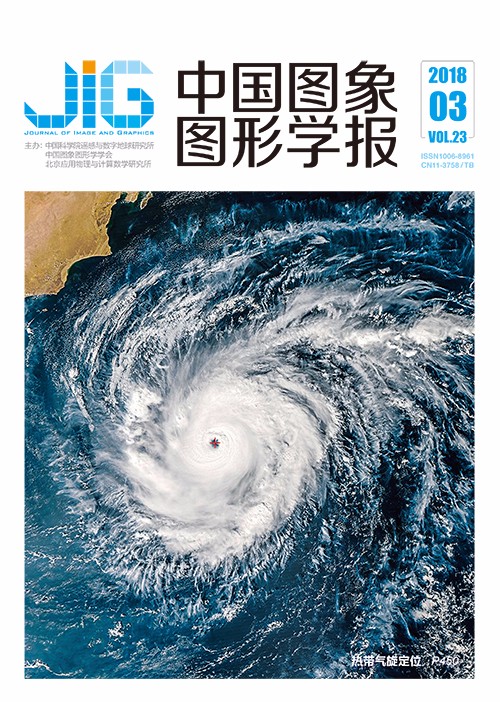
融合T节点线索的图像物体分割
摘 要
目的 图像分割是计算机视觉、数字图像处理等应用领域首要解决的关键问题。针对现有的单幅图像物体分割算法广泛存在的过分割和过合并现象,提出基于图像T型节点线索的图像物体分割算法。方法 首先,利用L0梯度最小化方法平滑目标图像,剔除细小纹理的干扰;其次,基于Graph-based分割算法对平滑后图像进行适度分割,得到粗糙分割结果;最后,借助于图像中广泛存在的T型节点线索对初始分割块进行区域合并得到最终优化分割结果。结果 将本文算法分别与Grabcut算法及Graph-based算法在不同场景类型下进行了实验与对比。实验结果显示,Grabcut算法需要人工定位边界且一次只能分割单个物体,Graph-based算法综合类内相似度和类间差异性,可以有效保持图像边界,但无法有效控制分割块数量,且分割结果对阈值参数过分依赖,极易导致过分割和过合并现象。本文方法在降低过分割和过合并现象、边界定位精确性和分割准确率方面获得明显改进,几组不同类型的图片分割准确率平均值达到91.16%,明显由于其他算法。处理图像尺寸800×600像素的图像平均耗时3.5 s,较之其他算法略有增加。结论 与各种算法对比结果表明,该算法可有效解决过分割和过合并问题,对比实验结果验证了该方法的有效性,能够取得具有一定语义的图像物体分割结果。
关键词
Image object segmentation algorithm by T junctions information
Cao Fengyun1, Hu Yujuan1, Wang Hao2, Shi Peibei1(1.Department of Public Computer Teaching, Hefei Normal University, Hefei 230601, China;2.College of Computer Science and Technology, Hefei University of Technology, Hefei 230009, China) Abstract
Objective Object segmentation from a single image is a fundamental step in many computer vision and digital image processing applications, such as image semantic recognition, medical image analysis, traffic control, weather forecasting, image searching, geological exploration, and scene understanding. Traditional image segmentation methods mainly use low-level semantic information of an image, which includes the color, texture, and shape of image pixels. This method is not ideal because it easily causes oversegmentation and overmerging in the actual segmentation of a complex scene. Obtaining semantic segmentation results is difficult. A novel approach that combines graph-based algorithm and t junction cues is proposed to improve the oversegmentation and merging of a single image object segmentation algorithm. Method On the basis of the Graph-based algorithm, t junction cues are introduced, which can guarantee accurate segmentation results to avoid the influence of color information on segmentation. First, L0 gradient minimization is applied to smooth the target image and eliminate artifacts caused by noise and texture detail. The L0 gradient minimization algorithm uses the number of non-zero gradients in the image to retain useful edge details in the image and removes useless edge parts. Thus, image smoothing is achieved. The L0 gradient minimization algorithm achieves edge-preserving smoothing without changing the artwork structure. The initial oversegmentation result of the smoothing image uses the Graph-based algorithm. The Graph-based algorithm considers the similarity between regions and the differences between regions and maintains image boundaries better. However, it cannot control the number of image blocks and the compact program. A region merging algorithm is applied to optimize the error segmentations by t junction cues. Result The proposed algorithms are compared with the Grabcut algorithm and the Graph-based algorithm under different scene types. Experimental results show that the Grabcut algorithm of artificial boundary and positioning is only a single object segmentation. The proposed algorithm has advantages in terms of robustness, time consumption, and boundary location accuracy over the Grabcut algorithm. The Graph-based method considers the similarities between and differences among regions. The image boundaries can be maintained well by segmenting the vertices in the graph. However, the defects of the Graph-based algorithm are obvious, such as class difference. Moreover, the number and the compactness of the image blocks are not controlled, and the segmentation effect depends strongly on the selected threshold. Oversegmentation and overmerging occur easily. The average rate of segmentation accuracy for several groups of different types of images reaches 91.16% given other algorithms. The image size of 800×600 pixels and the average time of 3.5 s increased slightly compared with other algorithms. The proposed algorithm is more time consuming than the Graph-based algorithm, but segmentation accuracy is greatly improved. The proposed algorithmcan generate concise and smooth segmentation boundaries and obtain segmentation results with some semantics. Conclusion This study proposes the object segmentation algorithm of a single image on the basis of t junction cues. A comparison of the proposed algorithm and the traditional graph-based and improved Grabcut algorithms shows the effectiveness of the proposed algorithm. Moreover, the proposed algorithm can effectively solve the problem of oversegmentation and overmerging, and semantic object segmentation results can be achieved. Experimental results show the effectiveness of the proposed algorithm.
Keywords
image segmentation T junction L0 gradient minimization Graph-based algorithm image segementation evaluation
|



 中国图象图形学报 │ 京ICP备05080539号-4 │ 本系统由
中国图象图形学报 │ 京ICP备05080539号-4 │ 本系统由